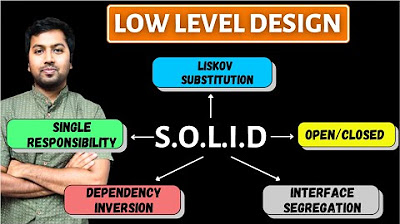Everything about software abstractions in 23 minutes
Summary
TLDRThis video discusses the importance of creating maintainable and flexible software designs. The speaker emphasizes the need to address architectural changes immediately, avoid over-engineering, and be open to adapting existing abstractions. By focusing on deep modules with simple interfaces and minimizing leaky abstractions, developers can ensure their code remains adaptable in the long run. The speaker also suggests using wrappers when integrating third-party libraries to preserve the application’s domain-specific data format, highlighting the balance between design simplicity and code efficiency.
Takeaways
- 😀 Postpone architectural changes when you notice diverging abstractions or increasing complexity in your code.
- 😀 Inline your code when necessary and revisit it later for improvements to avoid cluttering existing abstractions with conditionals.
- 😀 Software correctness and software design are distinct—correct algorithms don't guarantee good software design.
- 😀 Embrace the idea that you might not always be correct in your initial implementation, and be open to revising it for better design.
- 😀 A paradigm shift is needed to recognize that good software design is an evolving process, not just about being right the first time.
- 😀 People often get attached to early abstractions; acknowledge when your approach was wrong and refactor accordingly.
- 😀 When using third-party components that require a specific data format, wrap them to avoid changing your application’s internal format.
- 😀 Wrapping third-party components reduces complexity by minimizing data format changes and helps keep your domain-specific data intact.
- 😀 Avoid overengineering by creating unnecessary abstractions around external libraries—focus on minimizing complexity instead.
- 😀 Create deep modules with simple interfaces that hide complexity and minimize leaky abstractions in your software design.
Q & A
What is the primary purpose of software design in the context of the video?
-The primary purpose of software design is to make the code understandable, maintainable, and extensible over time. The goal is to structure the code in a way that allows for easy modifications and growth without becoming overly complex.
Why should developers avoid postponing architectural changes in software?
-Postponing architectural changes can lead to increasing complexity and the buildup of problematic abstractions. When developers notice areas where their design diverges, they should address it immediately to prevent further complications.
What does the speaker mean by 'inline the code'?
-Inlining the code refers to directly implementing necessary changes within the code, rather than trying to abstract or delay the change. This approach helps developers to avoid over-complicating the design while addressing issues immediately.
How does the concept of software correctness differ from software design?
-Software correctness refers to the accuracy and functionality of the code in performing its intended tasks, while software design is more concerned with the structure and architecture of the code. Good design allows for maintainability and flexibility, even if the initial implementation isn’t perfect.
What is a common mistake developers make when dealing with reusable functions and classes?
-A common mistake is rushing to implement reusable functions and classes without considering whether they are truly needed or whether they contribute to simplicity. Developers should prioritize creating deep modules with simple interfaces and only introduce reusable components when they make sense for the codebase.
What role do 'leaky abstractions' play in software design?
-Leaky abstractions occur when the internal workings of a module or component become exposed to the rest of the codebase. These should be minimized, as they complicate the understanding and maintenance of the code, undermining the purpose of abstraction in simplifying complexity.
What is the purpose of creating a wrapper around third-party components, as described in the video?
-The purpose of creating a wrapper around third-party components is to avoid repeated mapping of data across multiple places in the codebase. It allows the code to continue using the third-party component while keeping the application's internal data format consistent, reducing complexity.
Why should developers avoid overengineering when creating wrappers for third-party libraries?
-Overengineering occurs when unnecessary abstractions or wrappers are added to every third-party library. This can introduce more complexity than needed. Wrappers should only be created to reduce the impact of external dependencies on the application’s internal structure, not for every external library.
What does the speaker mean by 'deep modules with simple interfaces'?
-Deep modules with simple interfaces refer to software components that are internally complex but present a straightforward and easy-to-use interface to other parts of the code. The aim is to hide the complexity within the module while keeping the interactions with it simple and intuitive.
How does a paradigm shift in thinking about software design affect developers' approach to implementation?
-A paradigm shift in thinking involves acknowledging that a developer may not always be correct in their initial implementation. It encourages a mindset where developers are more open to revising and changing their code when needed, rather than clinging to previous decisions out of pride or attachment to certain abstractions.
Outlines

This section is available to paid users only. Please upgrade to access this part.
Upgrade NowMindmap

This section is available to paid users only. Please upgrade to access this part.
Upgrade NowKeywords

This section is available to paid users only. Please upgrade to access this part.
Upgrade NowHighlights

This section is available to paid users only. Please upgrade to access this part.
Upgrade NowTranscripts

This section is available to paid users only. Please upgrade to access this part.
Upgrade NowBrowse More Related Video
5.0 / 5 (0 votes)





